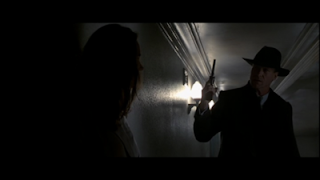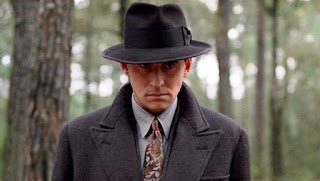I’m a cinafile. Anyone that’s kept
up with this blog or knows me personally could probably tell you as much but
leave it to me to think that it needs more of an explanation. It means more than
just being a “movie nerd” or a “film buff”. I’m those things as well but it’s
more than that. You see, I don’t read much, I don’t take in plays and I don’t
follow television shows or go to art exhibits. I love music but although my
collection is somewhat obscure, it’s not what you would call eclectic. I love
cinema. It is the artistic expression that speaks to me the most and it is the
medium that I would prefer you tell me a story through.
Film is its own art form. It utilizes
actors, typically reading from a script but is not a video recorded version of
a play. Nor is it a visual telling of a piece of literature although writing is
usually a big part of a film. It is an abstract art that is used to express
ideas, philosophies and feelings and it is often, but not always used to tell a
story. There are many aspects of cinema that make it its own art form but the
two that stand out most prominently are cinematography and editing. These are
the two pillars of artistic expression that have always assured cinema’s
uniqueness. Cinematography and editing are both technical skills and artistic
crafts at the same time. The cinematographer is charged with knowing the
equipment used in shooting a scene and properly conveying the tone and feel of
that scene. The editor deals with the technical aspects of post production and
is also very influential in the overall artistic tone, feel and pace of the
film. It is their job to use their skills and artistic input to properly convey
the vision of the director to the final piece of art.

All of this being said, a very
large number of films are based on previously created properties; much of this
is literature. Just in the past few years we’ve seen some very popular lit
adapted to the big screen including:” Harry Potter”,” Twilight”, “The Girl with
a Dragon Tattoo”,” The Watchmen” and now “Hunger Games”. Inevitably, when a new
film is coming out that’s based on works as popular as these; you will hear the
same questions and concerns arise from the fan base of these books. Among these
questions seems to always be: “Is the film going to stay true to the book?”
This is a question that the fans of literature absolutely have the right to ask
and their concerns are usually pretty understandable. The problem is that what
we sometimes end up with is the literary community dictating a piece of cinema.
And no matter what anybody tells you, words on a page are never cinematic. They
may have the potential to be so someday. But until the scenes are shot and cut,
the cinematic telling of that story doesn’t exist.

Peter Benchley wrote a book
inspired by a rash of shark attacks on the New Jersey shoreline. Later, Steven
Spielberg would direct a cinematic adaptation of this book and effectively
change the film industry forever. He created the first summer blockbuster but
he most certainly didn’t do it by staying true to Benchley’s book. “Jaws” is
one of the finest, most groundbreaking and exciting films ever made and it left
a permanent watermark on cinematic history. It happens to be based on a very long
book about a shark that eventually dies from exhaustion or something. It’s very
anticlimactic.
David Fincher’s “The Social
Network” is another great example. I’m not sure (nor do I care) how good the
book is but what Fincher and screenwriter Aaron Sorkin created is pretty
amazing. Fincher’s editing style is always noteworthy but especially in this
film. This story contains two separate timelines telling the entirety of the
back-story through flashbacks…. That’s three timelines. The only reason that
this is not the most confusing film ever made is because of how smooth and
coherent the editing is. Trent Reznor’s score is just the icing on the cake.
In contrast, Stephen Daldry made an
Oscar nominated film a few years ago based on “The Reader”. The story is
compelling and the acting was great but I still left the film with the feeling
that I would have gotten much more from the book. Ultimately, the film was
pretty good but with that story, it probably could and should have been great.
Unfortunately, the film was just not very cinematic. A lot of the scenery was
very beautiful but there is so much more to cinematography than shooting a
picturesque scene. And the scenes were cut together in a very straightforward
way. In short, no risks were taken to insure the film could be seen as its own
piece of art.
What’s that you say?... You want me
to write more about Zack Snyder and why he’s my least favorite filmmaker?...
Well… Ok… Just for you… “300” and “The Watchmen” are my two favorite examples
of what a filmmaker shouldn’t do. These movies are the perfect examples of the
difference between a cinematic adaptation of source material and a movie
version of a book. These films steal their aesthetic from the novels to the
point that you never really see Snyder’s vision on screen. He has no artistic
input and the films feel as though they are not connected to him. I’ve heard “300”
called visionary. This may be true; it’s just Frank Miller’s vision, not Zack
Snyder’s. I always chuckle to myself
when I think about him in preproduction, thinking he’s being very clever. “Storyboarding?
We don’t need to storyboard; I just cut out the pages from the novel and pasted
them to this poster board…”
Sometimes, as is in the case of
period pieces and biopics, the source material is historical fact. It is just
unnecessary in these cases to stay true to historical accuracy. Quintin Tarantino
made a masterpiece in 2009 called “Inglourious Basterds” without any regard for
historical accuracy. He didn’t even find it necessary to spell it correctly. This
film took liberties with a subject matter that many think was off limits. He chose
rather to rewrite history and give us the prequel to the Tarantino world that
many of us cinefiles have been living in since the early 90’s. The end result
was a 160 minute love letter to cinema and my favorite film from the past
decade.

Filmmaking is not an easy
profession to get into. If it was, I would be too busy making a film to write
this blog. Just like any other art, those who can do it professionally have an enormous
amount of passion for their medium. These people have typically grown up with
the art form and developed a love for it largely because of those who have come
before them. They are all fellow cinefiles. And excuse me if I sound a bit
entitled but, I (we) should be your target audience. Why not make films for
film lovers? Although the filmmaker will many times feel that it is his job to
do the source material justice; after all, it is the piece of art that inspired
the film in the first place. That source material will always be justified by a
great piece of inspired cinema…. and never by a bad movie…. No matter what
Stephen King thinks.












